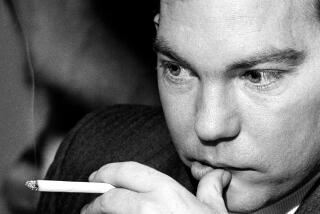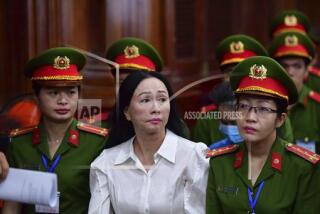Twenty Years Later, My Lai Remains a Symbol of Shame
Wednesday is the 20th anniversary of the massacre of civilians by U.S. troops at the Vietnamese village of My Lai. The writer, who covered the Vietnam War as an Associated Press correspondent for 10 years and was the AP’s last Saigon bureau chief, returned to Southeast Asia a decade after the war ended and visited My Lai in December, 1984.
At 7:22 on a Saturday morning 20 years ago, Charlie Company lifted off in helicopters with rifles on their arms and revenge in their hearts. The infantrymen were on a mission to My Lai that would become synonymous with shame and cover-up.
Two minutes after they were airborne on that day, March 16, 1968, U.S. artillery guns firing in support from Landing Zone Uptight indiscriminately shelled the village. Helicopter gunships raked the landing zone with rockets and machine-gun fire.
The thundering artillery, the whistling rockets and the steady clatter of machine guns sent villagers who had been working in the rice paddies diving for cover along the dikes and in the buffalo pits in the fields. Others, like Pham Thi Trinh, then a 10-year-old schoolgirl, and her family, took refuge in homemade shelters in front of their huts.
As the troop-carrying helicopters from Task Force Barker made their final approach, smoke from fires touched off by the artillery poured into the skies. At 7:30, the first troops landed, aroused about a grudge operation aimed at evening the score for the American casualties suffered from mines, booby traps and snipers.
“The attitude of all the men, the majority, I would say, was a revengeful attitude,” said Gregory Olson in testimony at a military inquiry into the My Lai assault. “They all felt a little bad because (we) lost a number of buddies to My Lai.”
“People were talking about killing everything that moved,” recalled another participant, Robert Pendleton. “Everyone knew what we were going to do.”
They had been briefed the day before on their target: the 48th Viet Cong local force battalion, perhaps as many as 250 troops that intelligence said posed a threat to the provincial capital of Quang Ngai City six miles away. Their mission: to destroy their supply base and staging area.
“When we left the briefing, we felt we were going to have a lot of resistance and we knew we were supposed to kill everyone in the village,” William Lloyd said.
Capt. Ernest L. Medina, the commander of Charlie Company, told his troops that the civilians would be on their way to the local marketplaces in Quang Ngai City by 7 a.m. But that was not the case.
Charlie Company’s 1st Platoon, led by Lt. William L. Calley Jr., moved into My Lai firing at fleeing Vietnamese, throwing grenades into houses and bunkers, and slaughtering animals.
“We heard the sound of American soldiers,” Pham Thi Trinh told a reporter years later. “People hiding in the shelter got out as they usually did when Americans entered the village.” The U.S. troops ordered her family and four neighbors to the front of the house, she said. She hid in a bedroom.
“They shot to death three cows first,” she said. “Then they knelt and shot my family. People tried to run away. My parents, six brothers and sisters, grandmother and aunt and uncle were killed.”
After shooting her mother, she said, the Americans placed straw on the woman and lighted it. She said that when her 14-year-old sister ran from the burning kitchen of their home, laughing soldiers forced her back into the fire. Pham Thi Trinh ran to her 76-year-old grandmother’s house and found her body partly inside a clothes cupboard where she had tried to hide.
Vo Thi Lien, then 11, was in a shelter with her grandparents.
“I saw three American soldiers point guns and shoot into the shelter and then throw grenades into it and hit my grandmother,” she said. Numbed and unable to find a way out of the collapsing shelter, she and her grandfather finally were rescued by some villagers.
By the time Charlie Company left My Lai in the early afternoon, its troops had killed at least 175 Vietnamese men, women and children, according to the 1970 report of the Army inquiry headed by the late Lt. Gen. William R. Peers.
“The evidence indicates that only three or four were confirmed as Viet Cong, although there were undoubtedly several unarmed Viet Cong men, women and children among them and many more active supporters and sympathizers,” the Peers Report said.
Separate estimates by the Criminal Investigation Division of the Army together with other evidence indicated that more than 400 civilians were killed.
A plaque in My Lai is inscribed with the names of 504 men, women and children Vietnamese officials say died in the massacre.
The only American casualty reported in Charlie Company was a soldier who was wounded by the discharge of his rifle.
Members of Calley’s platoon testified before the Peers inquiry that an old man was bayoneted to death and another man was thrown alive into a well and killed with a hand grenade.
Of Calley, the central figure of My Lai, the Peers Report said: “He directed and supervised the men of his platoon in the systematic killing of many noncombatants in and around My Lai. He personally participated in the killing of some noncombatants.”
Of the leader of the 2nd Platoon, Lt. Steven K. Brooks, one of four officers involved in My Lai who were killed in action in the following months, the report said: “He directed and supervised the men of his platoon in the systematic killing of at least 60 to 70 noncombatants. Although he knew that a number of his men habitually raped Vietnamese women in villages during operations, on 16 March, 1968, he observed, did not prevent and failed to report several rapes by members of his platoon while in My Lai . . . and Binh Tay.”
Some Vietnamese were spared by the courage of an American helicopter pilot who threatened to fire on his fellow soldiers if they harmed a group of 12 to 16 Vietnamese women, children and old men cowering in a bunker.
Warrant Officer Hugh Thompson landed his helicopter near the bunker and ordered his crew to fire on the American infantrymen if they fired on the Vietnamese while he was trying to get them evacuated.
Thompson said he asked a lieutenant to help get the women and children out, and the infantry officer replied that the only way to get them out was with a hand grenade. Thompson snapped back to the lieutenant: “Just hold your men right where they are and I’ll get the kids out.” The Vietnamese were safely evacuated.
The outside world knew nothing of My Lai for more than a year. The Peers inquiry cited 28 officers ranging from generals to enlisted men for covering up the massacre.
On March 29, 1969, Ron Ridenhour, a Vietnam veteran, sent letters to 30 military and congressional leaders saying he had heard many reports from soldiers who had served in Charlie Company that something “very black” had happened in My Lai and a public investigation should be made.
Calley Court-Martialed
Eight months later, on Nov. 24, 1969, Calley was ordered court-martialed on charges of premeditated murder of 109 Vietnamese.
“If I have committed a crime,” Calley said in his defense, “the only crime that I have committed is in judgment of my values. Apparently I have valued my troops’ lives more than I did that of the enemy. When my troops were getting massacred and mauled by an enemy that I couldn’t see, I couldn’t feel and I couldn’t touch, that nobody in the military ever described as anything other than communism.
“They didn’t give it a race, they didn’t give it a sex, they didn’t give it an age. They never let me believe it was just a philosophy in a man’s mind. That was my enemy out there, and when it came between me and that enemy, I had to value the lives of my troops. And I feel that is the only crime I have committed.”
In March, 1971, a jury of six senior officers convicted Calley of first-degree murder of at least 22 villagers, including a boy fleeing in terror whom Calley tossed into a ditch and shot.
Life Sentence
Calley was ordered to spend life in prison.
His conviction and sentence touched off a public outcry in his support, including national petition campaigns, angry speeches in Congress and appeals to then-President Richard M. Nixon to pardon him. Five months later, Nixon reduced his sentence to 20 years.
Calley actually served three years under house arrest at Ft. Benning, Ga. He was released when his conviction was overturned by a federal district judge. He was not returned to house arrest when the U.S. 5th Circuit Court of Appeals reinstated the conviction.
Calley was the only soldier convicted in the My Lai massacre, but it became the graveyard for several Army careers.
Six of 25 Tried
Initially, 25 officers and enlisted men were charged, 13 of them accused of direct involvement in the killing. But only six were actually tried, including Medina, the company commander.
The highest-ranking officer tried, Col. Oran K. Henderson, commander of the 11th Infantry Brigade, of which Charlie Company was a part, was acquitted of charges of failing to conduct an investigation after he was told that civilians had been killed.
Administrative action was taken against two generals, one of them demoted and the other censured.
The Peers Report said that no single factor was the cause of My Lai.
Barker’s Plan Faulted
The battle plan by Lt. Col. Frank A. Barker, commander of the task force bearing his name, contained inaccurate intelligence on the strength and whereabouts of the Viet Cong and wrongly assumed that no civilians would be in the area, the report said. It said Barker and his subordinates failed to make any clear distinction between soldiers and civilians.
Barker was killed in a helicopter crash three months later.
The report said that many men in Charlie Company disliked and mistreated Vietnamese civilians. And they did not trust them because they failed to warn the Americans of mines and booby traps, which took a heavy toll of casualties, frustrating and demoralizing the U.S. troops.
Another contributing factor, the report said, was the attitude of South Vietnamese officials themselves toward the My Lai area, which they considered Viet Cong-controlled territory and treated as a free-fire zone with little concern about the villagers. This attitude rubbed off on the Americans, the report said.
Shocked the Nation
Although atrocities were committed by both sides in the Vietnam War, My Lai shocked the United States, a nation that took pride in fighting by the rules of war.
Today, My Lai is a memorial to its victims. The bodies of the men, women and children rest in the cemeteries and surrounding fields.
In the center of the village is a large statue of a woman holding a child in her left arm. At her feet are victims of the massacre.
My Lai was reborn when the war ended in 1975. Twenty years after the attack, it is alive again with the scent of flowers in bloom and the laughter of a new generation of children.
More to Read
Sign up for Essential California
The most important California stories and recommendations in your inbox every morning.
You may occasionally receive promotional content from the Los Angeles Times.










